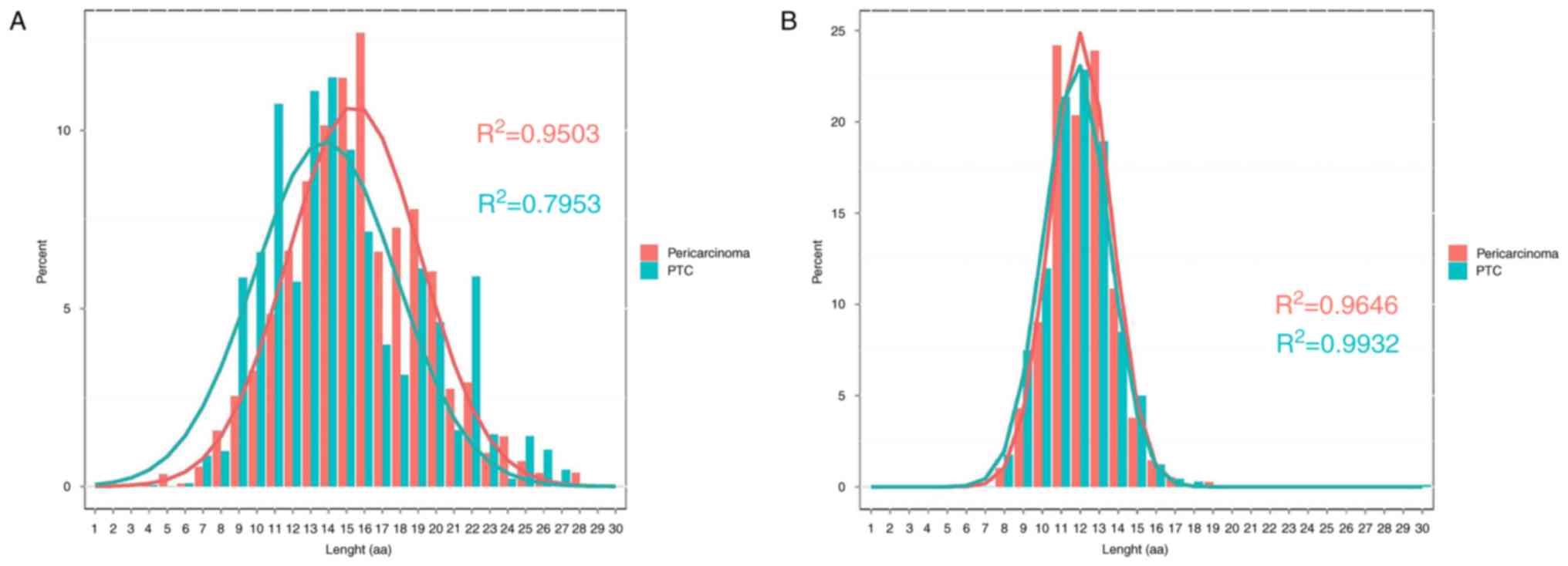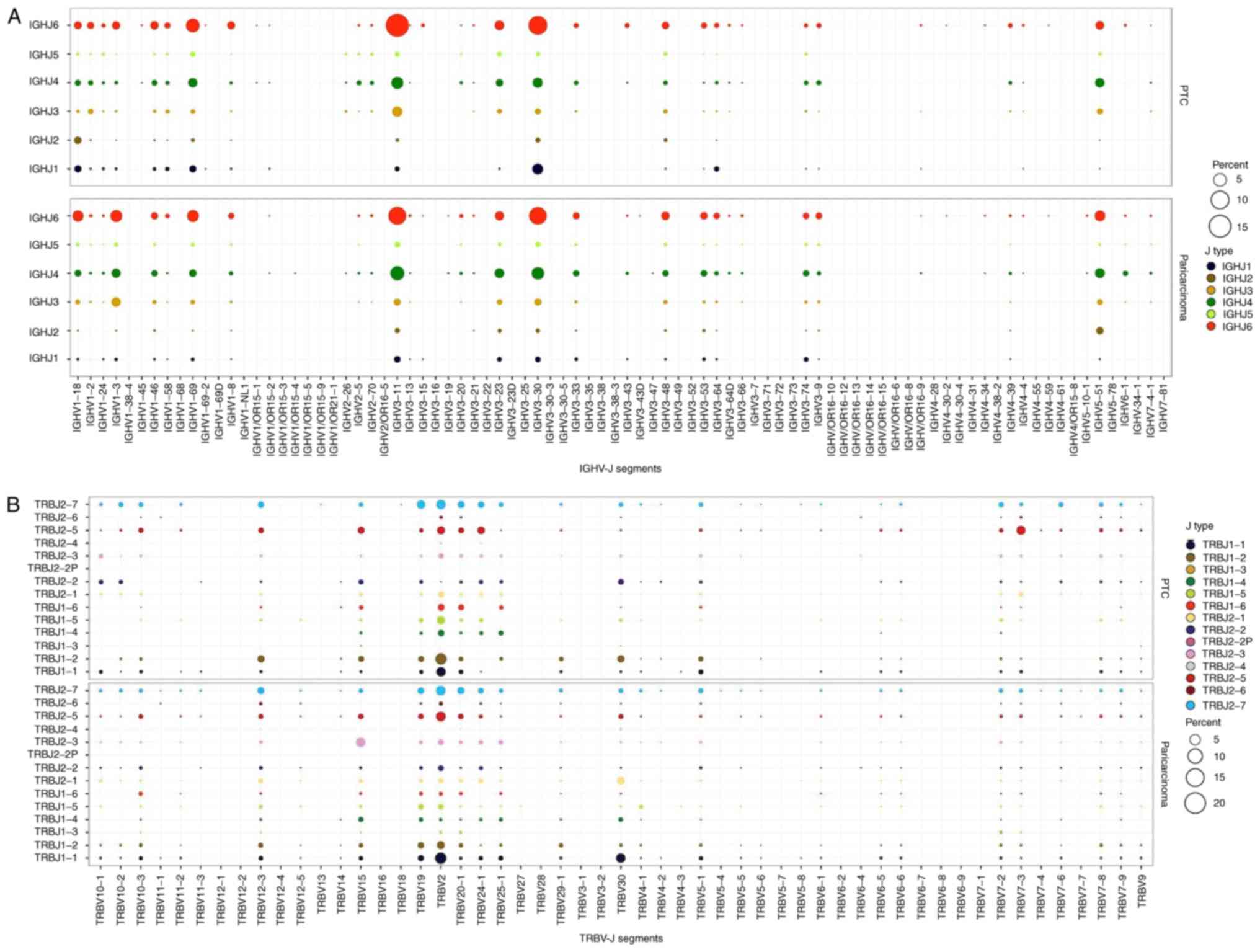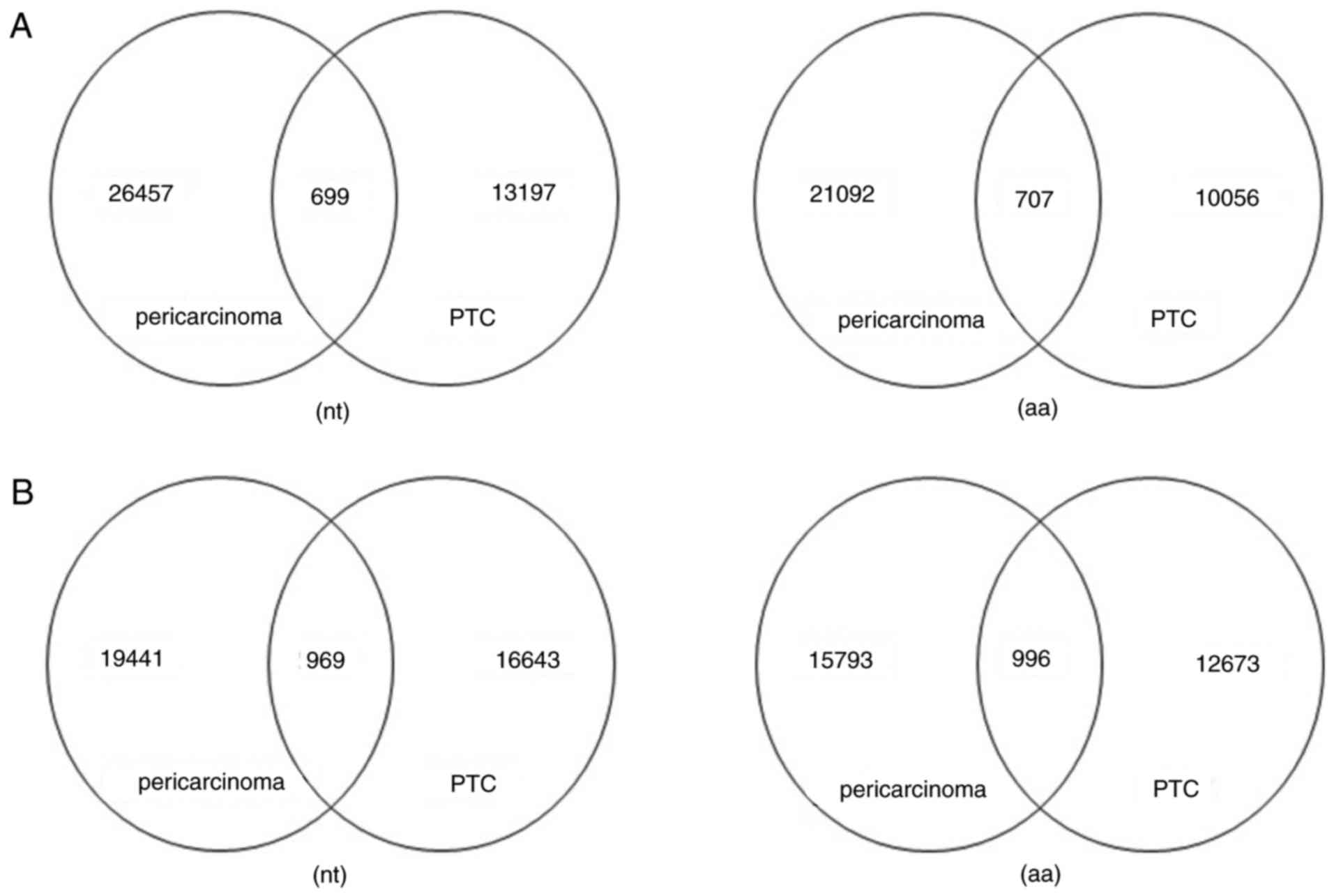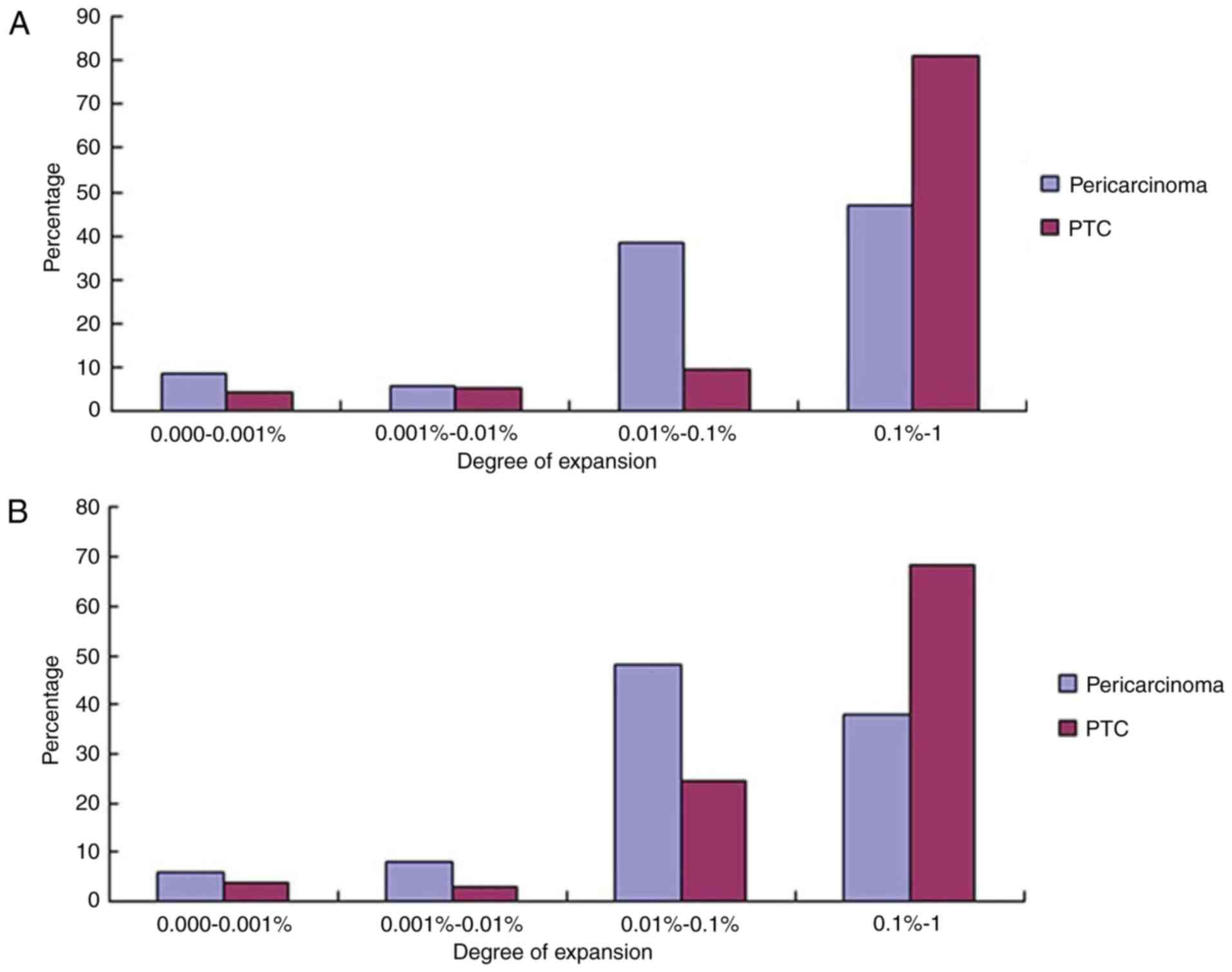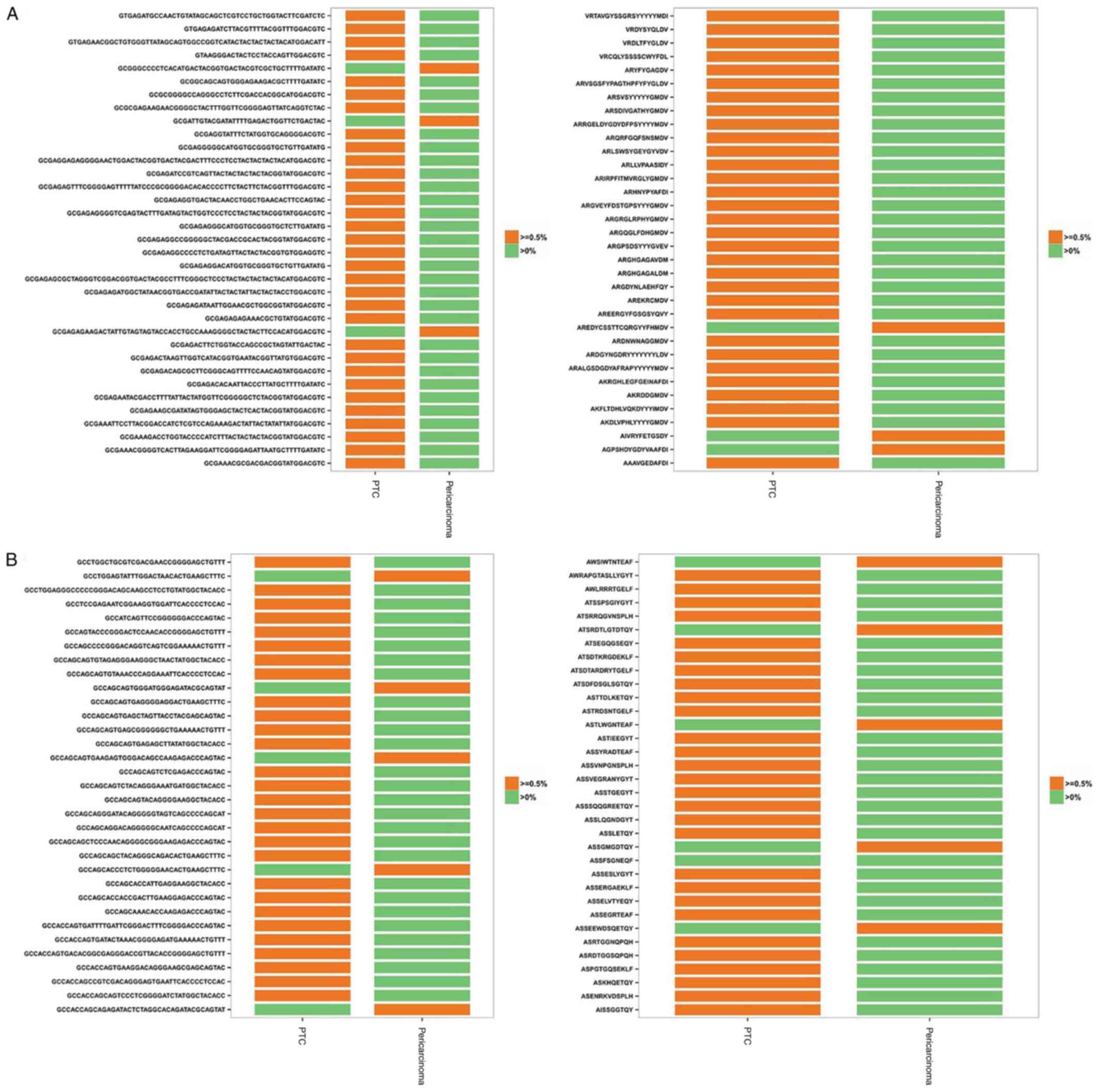|
1
|
Jung CW, Kong JS, Seol H, Park S, Koh JS,
Lee SS, Kim MJ, Choi IJ and Myung JK: Expression of activated
Notch1 and Hey1 in papillary thyroid carcinoma. Histopathology.
70:301–308. 2017. View Article : Google Scholar : PubMed/NCBI
|
|
2
|
Georgiades F, Vasiliou G, Kyrodimos E and
Thrasyvoulou G: Extensive laryngeal infiltration from a neglected
papillary thyroid carcinoma: A case report. World J Clin Cases.
4:187–190. 2016. View Article : Google Scholar : PubMed/NCBI
|
|
3
|
Chen W, Zheng R, Zeng H, Zhang S and He J:
Annual report on status of cancer in China, 2011. Chin J Cancer
Res. 27:2–12. 2015. View Article : Google Scholar : PubMed/NCBI
|
|
4
|
Zhu H, Lv Z, An C, Shi M, Pan W, Zhou L,
Yang W and Yang M: Onco-lncRNA HOTAIR and its functional genetic
variants in papillary thyroid carcinoma. Sci Rep. 6:319692016.
View Article : Google Scholar : PubMed/NCBI
|
|
5
|
Wang T, Blumer I, Boerner S and Asa SL:
Synchronous papillary carcinoma of thyroid and lung. Endocr Pathol.
27:268–270. 2016. View Article : Google Scholar : PubMed/NCBI
|
|
6
|
Moritani S: Parapharyngeal metastasis of
papillary thyroid carcinoma. World J Surg. 40:350–355. 2016.
View Article : Google Scholar : PubMed/NCBI
|
|
7
|
Calis JJ and Rosenberg BR: Characterizing
immune repertoires by high throughput sequencing: Strategies and
applications. Trends Immunol. 35:581–590. 2014. View Article : Google Scholar : PubMed/NCBI
|
|
8
|
Schanz M, Liechti T, Zagordi O, Miho E,
Reddy ST, Günthard HF, Trkola A and Huber M: High-throughput
sequencing of human immunoglobulin variable regions with subtype
identification. PloS One. 9:e1117262014. View Article : Google Scholar : PubMed/NCBI
|
|
9
|
Quail MA, Smith M, Coupland P, Otto TD,
Harris SR, Connor TR, Bertoni A, Swerdlow HP and Gu Y: A tale of
three next generation sequencing platforms: Comparison of ion
torrent, pacific biosciences and illumina Miseq sequencers. BMC
Genomics. 13:3412012. View Article : Google Scholar : PubMed/NCBI
|
|
10
|
Reuter JA, Spacek DV and Snyder MP:
High-throughput sequencing technologies. Mol Cell. 58:586–597.
2015. View Article : Google Scholar : PubMed/NCBI
|
|
11
|
Lefranc MP, Giudicelli V, Ginestoux C,
Bodmer J, Müller W, Bontrop R, Lemaitre M, Malik A, Barbié V and
Chaume D: IMGT, the international ImMunoGeneTics database. Nucleic
Acids Res. 27:209–212. 1999. View Article : Google Scholar : PubMed/NCBI
|
|
12
|
Hou X, Lu C, Chen S, Xie Q, Cui G, Chen J,
Chen Z, Wu Z, Ding Y, Ye P, et al: High throughput sequencing of T
cell antigen receptors reveals a conserved TCR repertoire. Medicine
(Baltimore). 95:e28392016. View Article : Google Scholar : PubMed/NCBI
|
|
13
|
Sui W, Hou X, Zou G, Che W, Yang M, Zheng
C, Liu F, Chen P, Wei X, Lai L and Dai Y: Composition and variation
analysis of the TCR β-chain CDR3 repertoire in systemic lupus
erythematosus using high-throughput sequencing. Mol Immunol.
67:455–464. 2015. View Article : Google Scholar : PubMed/NCBI
|
|
14
|
Yu X, Almeida JR, Darko S, van der Burg M,
DeRavin SS, Malech H, Gennery A, Chinn I, Markert ML, Douek DC and
Milner JD: Human syndromes of immunodeficiency and dysregulation
are characterized by distinct defects in T-cell receptor repertoire
development. J Allergy Clin Immunol. 133:1109–1115. 2014.
View Article : Google Scholar : PubMed/NCBI
|
|
15
|
Robins H: Immunosequencing: Applications
of immune repertoire deep sequencing. Curr Opin Immunol.
25:646–652. 2013. View Article : Google Scholar : PubMed/NCBI
|
|
16
|
Li D, Gao G, Li Z, Sun W, Li X, Chen N,
Sun J and Yang Y: Profiling the T-cell receptor repertoire of
patient with pleural tuberculosis by high-throughput sequencing.
Immunol Lett. 162:170–180. 2014. View Article : Google Scholar : PubMed/NCBI
|
|
17
|
Miqueu P, Guillet M, Degauque N, Doré JC,
Soulillou JP and Brouard S: Statistical analysis of CDR3 length
distributions for the assessment of T and B cell repertoire biases.
Mol Immunol. 44:1057–1064. 2007. View Article : Google Scholar : PubMed/NCBI
|
|
18
|
Zhu D, McCarthy H, Ottensmeier CH, Johnson
P, Hamblin TJ and Stevenson FK: Acquisition of potential
N-glycosylation sites in the immunoglobulin variable region by
somatic mutation is a distinctive feature of follicular lymphoma.
Blood. 99:2562–2568. 2002. View Article : Google Scholar : PubMed/NCBI
|
|
19
|
Radcliffe CM, Arnold JN, Suter DM, Wormald
MR, Harvey DJ, Royle L, Mimura Y, Kimura Y, Sim RB, Inogès S, et
al: Human follicular lymphoma cells contain oligomannose glycans in
the antigen-binding site of the B-cell receptor. J Biol Chem.
282:7405–7415. 2007. View Article : Google Scholar : PubMed/NCBI
|
|
20
|
Nemzer LR: Shannon information entropy in
the canonical genetic code. J Theor Biol. 415:158–170. 2017.
View Article : Google Scholar : PubMed/NCBI
|
|
21
|
Brezinschek HP, Foster SJ, Brezinschek RI,
Dörner T, Domiati-Saad R and Lipsky PE: Analysis of the human VH
gene repertoire. Differential effects of selection and somatic
hypermutation on human peripheral CD5(+)/IgM+ and CD5(−)/IgM+ B
cells. J Clin Invest. 99:2488–2501. 1997. View Article : Google Scholar : PubMed/NCBI
|
|
22
|
Baranzini SE, Jeong MC, Butunoi C, Murray
RS, Bernard CC and Oksenberg JR: B cell repertoire diversity and
clonal expansion in multiple sclerosis brain lesions. J Immunol.
163:5133–5144. 1999.PubMed/NCBI
|
|
23
|
Emerson RO, Sherwood AM, Rieder MJ,
Guenthoer J, Williamson DW, Carlson CS, Drescher CW, Tewari M,
Bielas JH and Robins HS: High-throughput sequencing of T-cell
receptors reveals a homogeneous repertoire of tumour-infiltrating
lymphocytes in ovarian cancer. J Pathol. 231:433–440. 2013.
View Article : Google Scholar : PubMed/NCBI
|
|
24
|
McNeel DG: TCR diversity-a universal
cancer immunotherapy biomarker? J Immunother Cancer. 4:692016.
View Article : Google Scholar : PubMed/NCBI
|
|
25
|
Clemente MJ, Przychodzen B, Jerez A,
Dienes BE, Afable MG, Husseinzadeh H, Rajala HL, Wlodarski MW,
Mustjoki S and Maciejewski JP: Deep sequencing of the T-cell
receptor repertoire in CD8+ T-large granular lymphocyte leukemia
identifies signature landscapes. Blood. 122:4077–4085. 2013.
View Article : Google Scholar : PubMed/NCBI
|
|
26
|
Arstila TP, Casrouge A, Baron V, Even J,
Kanellopoulos J and Kourilsky P: A direct estimate of the human
alphabeta T cell receptor diversity. Science. 286:958–961. 1999.
View Article : Google Scholar : PubMed/NCBI
|
|
27
|
Ascierto PA, Capone M, Urba WJ, Bifulco
CB, Botti G, Lugli A, Marincola FM, Ciliberto G, Galon J and Fox
BA: The additional facet of immunoscore: Immunoprofiling as a
possible predictive tool for cancer treatment. J Transl Med.
11:542013. View Article : Google Scholar : PubMed/NCBI
|
|
28
|
Galon J, Pagès F, Marincola FM, Thurin M,
Trinchieri G, Fox BA, Gajewski TF and Ascierto PA: The immune score
as a new possible approach for the classification of cancer. J
Transl Med. 10:12012. View Article : Google Scholar : PubMed/NCBI
|
|
29
|
Galon J, Angell HK, Bedognetti D and
Marincola FM: The continuum of cancer immunosurveillance:
Prognostic, predictive, and mechanistic signatures. Immunity.
39:11–26. 2013. View Article : Google Scholar : PubMed/NCBI
|



